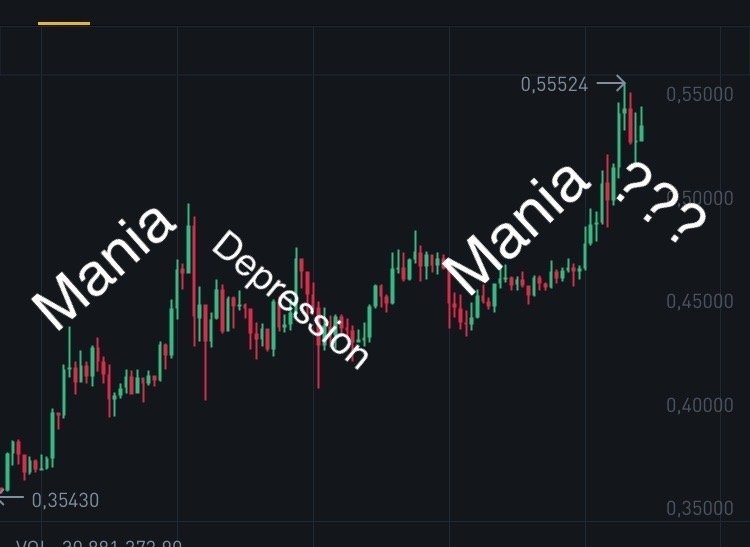 Bipolar Disorder – Or The Condition of The Crypto Community
Bipolar Disorder – Or The Condition of The Crypto Community

Dear Coilers, there is a thin borderline between the contentment and uncontentment. As we could see, last few days made quite a few people from the XRP Community extremely happy.
A few cents higher in price of the asset they hold made them forget the period of long three years of desperation.
Human psychology is very peculiar I must notice.
I myself am a realist. Most of the people I know say I am an irreparable pessimist, which I am not!
Two days ago I was on live Meet chat with few of the long term members of the Croatian XRP Community. We were chatting and following the price rise live, discussing the future. At one moment, around 2am it was, I said: Guys this pumped too high it’s time to sell!...
...A few moments later the price dumped heavily, the excitement faded and the chat was about to die. We wished ourselves a good night and left the Meet.
At the moment of writing this, “The Asset” is above the price from that day and the overall positivity is felt all around social networks. Again.
Then it crossed my mind... Great number of the investors have developed Bipolar disorder!!!
Bipolar Disorder (or Manic Depression) is a complex disorder that likely stems from a combination of genetic and non-genetic factors. The mood episodes associated with it involve clinical depression or mania (extreme elation and high energy) with periods of normal mood and energy in between episodes. The severity of mood episodes can range from very mild to extreme, and they can happen gradually or suddenly within a timeframe of days to weeks. When discrete mood episodes happen four or more times per year, the process is called rapid cycling. Rapid cycling should not be confused with very frequent moment-to-moment changes in mood, which can sometimes occur in people with bipolar disorder or other conditions such as borderline personality disorder.
Along with manic or depressive episodes, patients with bipolar disorder may have disturbances in thinking. They may also have distortions of perception and impairment in social functioning.
The depression symptoms of Bipolar disorder
The clinical depression symptoms seen with bipolar disorder are the same as those seen in major depressive disorder and include:
Decreased appetite and/or weight loss, or overeating and weight gain
Difficulty concentrating, remembering, and making decisions
Fatigue, decreased energy, being “slowed down”
Feelings of guilt, worthlessness, helplessness
Feelings of hopelessness, pessimism
Insomnia, early-morning awakening, or oversleeping
Loss of interest or pleasure in hobbies and activities that were once enjoyed, including sex
Persistent physical symptoms that do not respond to treatment, such as headaches, digestive disorders, and chronic pain
Persistently sad, anxious, or “empty” moods
Restlessness, irritability
Thoughts of death or suicide, suicide attempts
The signs of mania in Bipolar disorder:
Disconnected and very fast (racing) thoughts
Grandiose beliefs
Inappropriate elation or euphoria
Inappropriate irritability
Inappropriate social behavior
Increased sexual desire
Increased talking speed or volume
Markedly increased energy
Poor judgment and risk taking
A decreased need for sleep due to high energy
Have you ever experienced some of those symptoms connected to the price of the asset you invested in?
How Is Bipolar Disorder Treated?
Treatment for bipolar disorder may include the use of mood stabilizers such as lithium. Certain anticonvulsants, antipsychotics, and benzodiazepines may also be used to stabilize mood. Sometimes antidepressants are given in combination with mood stabilizers to boost the depressed mood, although antidepressants are often not as effective as some mood stabilizers or certain atypical antipsychotics for treating depression in bipolar disorder.
Mental illness is very big problem in modern world. Illness caused by big expectations and strong belief in the investment made, which will one day “solve all problems” can, in case of failure, cause big disappointment and clinical depression which in some cases can lead to suicide!
It is very important to stay sane and be a realist! Insane person is not able to make good decisions and I’m sure you wouldn’t like to make those wrong!














































